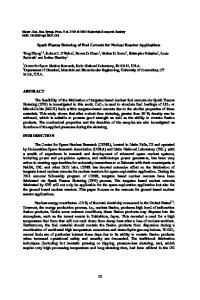Preparation of Nitride Fuel by Spark Plasma Sintering Technique
- PDF / 348,134 Bytes
- 6 Pages / 612 x 792 pts (letter) Page_size
- 85 Downloads / 380 Views
1043-T13-04
Preparation of Nitride Fuel by Spark Plasma Sintering Technique Hiroaki Muta, Ken Kurosaki, Masayoshi Uno, and Shinsuke Yamanaka Division of Sustainable Energy and Environmental Engineering, Graduate Shool of Engineering, Osaka University, 2-1 Yamadaoka, Suita, 565-0871, Japan ABSTRACT Spark plasma sintering (SPS) technique was applied for fabrication of UN pellets. The dense sample was obtained with relatively low sintering temperature without any milling process and sintering additive, indicating that the SPS technique is suitable for fabrication of nitride fuel. The thermal conductivity and Young’s modulus in axial direction were higher than those of reported values. Electron backscatter pattern (EBSP) analysis and electronic calculation supposed that weak grain orientation in [100] direction of the sample lead to these higher values. INTRODUCTION There is growing interest in nitride nuclear fuels for Fast Breeder Reactor and Accelerator-Driven Subcritical Reactor [1]. The high thermal conductivity, high melting point, and the wide solubility between (U,Pu)N and minor actinide nitride provide high degree of freedom for design of the reactors. In spite of the superior properties, several problems exist in the fabrication technique for utilization of nitride fuel. Several studies have been made on an extraction of 15-nitrogen and nonaqueous reprocessing method [2]. We focus on the high sintering-resistance of the nitride. Conventionally, milling process and/or sintering additive were necessary for fabrication of the high density nitride pellets. However, the fabrication process must be operated remotely, hence such additional processes were not desired. Additionally, high temperature and long time sintering process are not acceptable because some minor actinides have relatively-high vapor pressure at high temperatures. New sintering technique for preparation of high density nitride pellets has been desired. Spark plasma sintering (SPS) is a pressure-assisted sintering that utilizes an electric current. Schematic view of the apparatus is shown in Fig. 1. The sample temperature is raised and controlled by Joule heating in the sample and/or electronically conductive dies. The electric current generates high-temperature “spark plasma” at the surface of the sample particles. It sputters the inactive region on the particle, for example, the oxide layer on metal surface. The “cleaning” process drastically lowers the sintering temperature and time. We thought that restraining of minor actinide evaporation and easy densification of pellets could be expected by application of the sintering method for fabrication of nitride fuel pellets. In this study, UN powders were pelletized using the SPS technique with different sintering conditions. Sample density, microstructure, and several thermophysical properties were measured and compared with those of samples prepared by the conventional method. Fig.1. Schematic view of SPS apparatus.
EXPERIMENT 14
Percentage (%)
UN powder was purchased from 12 Mitsubishi Materia
Data Loading...











